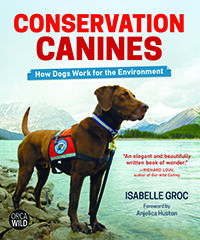Resilience
Conservation Dogs Offer Lessons of Hope and Resilience
Isabelle Groc's new kids book offers important lessons for them and adults.
Posted October 14, 2021 Reviewed by Vanessa Lancaster
I recently read a wonderful children's book1 titled Conservation Canines: How Dogs Work for the Environment written by the award-winning environmental writer, conservation photographer, and documentary filmmaker Isabelle Groc2 with a Foreword by Angelica Huston really made a deep impression on me. In addition to learning a lot about how conservation dogs help fix complex environmental problems3 and enjoy doing it, I realized that this wonderful book provides ample lessons for connecting youngsters, and I'm sure adults as well to wildlife species animals and showing how we need to protect their homes.
I couldn't agree more with this review of Conservation Canines: “Robust and engaging...Sure to be a hit with both children writing reports and those who enjoy books about animal companions and adventurous work. A must for school and public libraries.”—Booklist, starred review
I'm pleased Isabelle could take the time to answer a few questions about her inspirational and most important book. Here's what she had to say.
Marc Bekoff: Why did you write Conservation Canines?
Isabelle Groc: A few years ago, I was filming wildlife biologists who were studying the Oregon Spotted Frog in a wetland in British Columbia, Canada. This frog species, identified by its Latin name as Rana Pretiosa, the “precious frog,” is Canada’s most endangered amphibian and is very difficult to find. That day, the scientists had brought in Alli, an Australian cattle dog working for the organisation Conservation Canines (now with Rogue Detection Teams) to help track the elusive amphibian that humans had failed to locate.
I was amazed by the dog’s confidence and agility, and how quickly she was able to locate one of the frogs. Alli’s discovery was significant. Understanding where the frogs live is critical to their long-term survival. It means that wildlife managers can take steps to protect their habitat and reduce the threats they are facing. In the race against extinction, time is of the essence, and dogs are fast and efficient. I discovered that all over the world, dogs’ powerful sense of smell, boundless energy, and incredible communication skills were increasingly being used for wildlife conservation. I became fascinated with what those dedicated canines could do and I wanted to tell their stories.

MB: How does your book relate to your background and general areas of interest?
IG: I am a writer, conservation photographer, and filmmaker focusing on wildlife conservation, endangered species, and the relationships between people and the natural world. I am also passionate about engaging children and youth to experience the natural world and protect endangered species.
This new book is my third non-fiction book on wildlife conservation after Gone is Gone: Wildlife under Threat and Sea Otters: A Survival Story, and is looking to highlight actions that people are taking, this time with the help of conservation dogs, to create positive change for the planet in the context of growing pressures on the environment and the extinction crisis.
MB: Who is your intended audience?
IG: Dog lovers and anyone interested in animals, the environment, wildlife conservation, science, and photography.
MB: What are some of the topics you weave into your book and what are some of your major messages?
IG: Dogs are part of many children’s lives, and this book which contains lots of information on the animal-human bond and how canine noses work aims to inspire children and youth to look at the dogs in their own lives with renewed curiosity and compassion. The individual stories of the dogs helping wildlife are also an opportunity to learn more about complex environmental issues, including species trafficking, human-wildlife conflicts, or invasive species, and what can be done.
Many of the conservation canines portrayed in the book came from shelters and did not have any hope of getting adopted. Yet, their intense energy, obsession with play, and ability to focus make them ideal conservation dogs. They are given a new purpose and are helping wildlife species that are also running out of options. I hope everyone can appreciate this message of hope and resilience.
MB: How does your book differ from others that are concerned with some of the same general topics?
IG: Books have often highlighted the role of working dogs in helping with difficult tasks such as searching for drugs and explosives or locating missing persons. But canine superpowers are now increasingly used on behalf of wildlife conservation, and this book comprehensively looks at a vast range of environmental jobs held by canines.
The book not only focuses on detection dogs but also highlights the renewal of livestock guardian dogs that help people coexist with predators such as wolves and bears on the landscape. I have spent extended periods of time over the last 10 years documenting conservation canines in the field, and the book is illustrated with my own photographs, which I hope will personally connect readers to the world of these special working dogs.
MB: What are some of your current projects?
IG: I am currently completing a documentary on wolves, dogs’ ancestors. It is a film that explores our relationship today with wolves, and more generally the nature of our engagement to the wild.
MB: Is there anything else you'd like to tell readers?
IG: Human-wildlife conflict is on the rise, and predators are sadly too often misunderstood, under-appreciated, and persecuted in different parts of the world. In the book, I tell the stories of dogs that help people successfully coexist with predators: Anatolian shepherd dogs that protect farmers’ livestock against cheetah attacks in Namibia or Karelian bear dogs that keep people and bears safe in the United States. I hope these stories can give readers hope and inspiration for living in harmony with wildlife.
References
In conversation with Isabelle Groc. (Instagram: @isabellegroc)
Bekoff, Marc. For the Love of a Ball: Dogs as Conservation Biologists.




